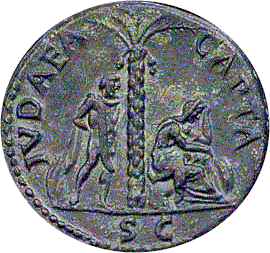

JUDAEA CAPTA
| Judaea Capta-mønterne skulle fejre den romerske sejr over jøderne i år 70. Vespasian og hans efterfølgere Titus og Domitian lader slå mønter over en lang årrække til minde om Judæas nederlag. På den ene side kejserportrættet; på den anden side en stående romersk soldat, og en sørgende kvinde og et palmetræ, der viser den geografiske placering. Teksten fortæller, at Judæa er taget. Triumferende mand overfor sørgende kvinde. Romer overfor jødinde. Det er den romerske symbolik: Manden er den aktive, stående og sejrende - kvinden den passive, sammensunkne og besejrede. |
Soon after the Temple at
Jerusalem was razed by the victorious troops led by Titus in 70 CE, his father - Emperor Vespasian -
launched an extensive issue of coins commemorating the hard fought Roman victory over the tiny Jewish
nation. The Judaea Capta series lasted for 25 years under Vespasian and his two sons who succeeded him
as Emperor - Titus and Domitian. These commemoratives were issued in bronze, silver and gold by mints
in Rome, the Roman Empire, and Judaea. |
 |
| Bronze Roman sestertius [quarter denarius] struck in 71 CE bearing laureate image of Vespasian with Latin inscription (reading clockwise from bottom): Imp[erator] Caes[ar] Vespasian[us] Aug[ustus] P[ontifex] M[aximus] Tr[ibunis] P[otentia]... The obverse side commemorates the conquest of Jerusalem the preceding year by portraying a woman mourning under a palm with the inscription Iudaea Capta. |
 |